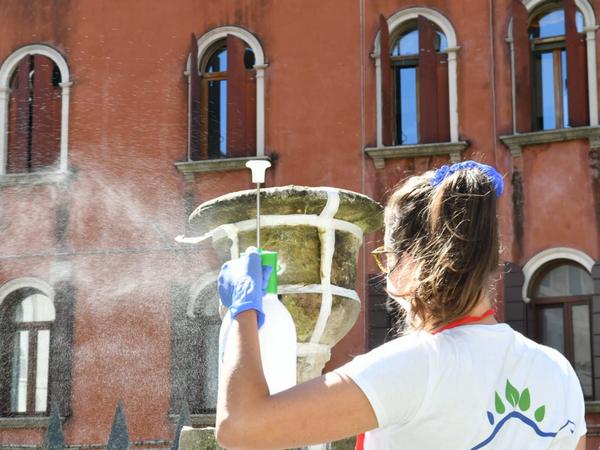Irene Scarpa and Nasier's success story is about innovative gels capable of removing various types of patina and restoring the beauty of every kind of artistic piece. It is, above all, a virtuous example of technology transfer from academia to business in the cultural heritage conservation area, which is very dear to Ca' Foscari University and Venice, its host city.
Ca' Foscari University, in collaboration with Brenta srl, the company that owns the intellectual property and is the sole manufacturer of Nasier, today presented an illustrative example of technology transfer that makes the most of the results of academic research and allows to create efficient, sustainable products for the selective removal of biological, organic and acrylic coats from stone, wood, textile, painting and paper artworks.
In order to promote and increase the appreciation of this invention, which has already won important awards, and the process that led to its creation, the Venice University, in collaboration with the company Brenta srl, organised a practical cleaning demonstration, applying one of the products in the Nasier line (specifically Nasier Lapideo L01) to a decorative element on a column of the balustrade located in the garden of Palazzo Ca' Dolfin, one of the University's buildings. At the same time, a conference was held in the Great Hall of the University to discuss with experts in the field the potential of the new method, which stands out for its degree of innovation and sustainability, the technologies applied to the cultural heritage and the knowledge transfer practices developed by the University.
The starting point for the idea was the observation in the field, by the then student Irene Scarpa, of the problems encountered with cleaning products that were invasive for the artworks and toxic for the environment and the operator. This led to the idea of translating into practical application the knowledge in bio and nanotechnologies acquired during Dr. Scarpa’s years of academic study.
The invention was born at Ca' Foscari when Irene Scarpa was a student in Chemical Sciences for Conservation and Restoration. She completed her studies in 2013 with a thesis focused on the removal of biological patinas from stone surfaces at the Baths of Caracalla, in collaboration with the Special Archaeological Heritage Authority of Rome (Soprintendenza Speciale per i Beni Archeologici di Roma).
An Italian patent application was then filed on 28 August 2015 and subsequently extended.
Together with Prof. Pietro Riello, Director of the Department of Molecular Sciences and Nanosystems, and other researchers, Dr. Irene Scarpa founded in 2016 the spin-off company Nasiertech with the aim of commercialising a range of products (Nasier) and specific solutions for the removal of biological, organic and acrylic patinas from various materials.
The university spin-off was eventually acquired, together with its industrial property, by the company Brenta Srl of the Nine Trees Group, which cooperates with Ca' Foscari University through the RICAP Programme (Research and Innovation Corporate Affiliates Programme). The company decided to invest in the industrial and commercial scale-up of the products.
The technology and knowledge transfer service of the University, PInK - Promotion of Innovation and Know-How, supported the development of the invention following the process step by step: from the patent application to the management of the relations with the company.
Nasier products consist of enzymes stabilised with inorganic and inert structures. They represent an innovative method for removing biological, organic and acrylic coatings from various surfaces. This technology changed the well-known enzymatic cleaning method into an efficient technique that can be applied to any kind of artwork, no matter how small or large. The products do not require constant pH and temperature adjustments, as is the case with enzymatic cleaning.
They are ecocompatible, non-toxic products, safe for the operator and the environment.
The products are ready to use and can be applied directly on the surface to be treated or on an interface layer above the affected area, acting in 45 minutes (stone works) and in 3-5 minutes (wooden icons, paintings, textiles and paper).
Compared to classic cleaning methods, Nasier products significantly reduce the number of applications needed to remove patinas, making the surface immediately ready for other restoration treatments, which can be easily alternated.
The entire Nasier range is completely odourless, green, fast and safe. It guarantees selective removal and respect for the integrity of the underlying surface because it acts exclusively on the patina to be removed, without altering the surface of the artwork, avoiding the formation of pigmentation phenomena, which can arise after cleaning from a lichen attack.
The subject “Technology and Cultural Heritage" was discussed in depth by Elisabetta Zendri (Department of Environmental Sciences, Informatics and Statistics, Ca' Foscari University); Pietro Riello (Director of the Department of Molecular Sciences and Nanosystems, Ca' Foscari University) analysed "The inventive process" while Vladi Finotto, Rector's Delegate for Intellectual Property, Self-Entrepreneurship and Technology Transfer (Ca' Foscari University) explored the issue of "Tech transfer: research, innovation and enterprise". Benedetta Leonetti (Principal Investigator Brenta srl) and Irene Scarpa, Head of Nasier Division Brenta, focused on the scientific aspects of the invention, while Andrea Castellin (General Manager Brenta srl) talked about scale-up and industrial applicability.











